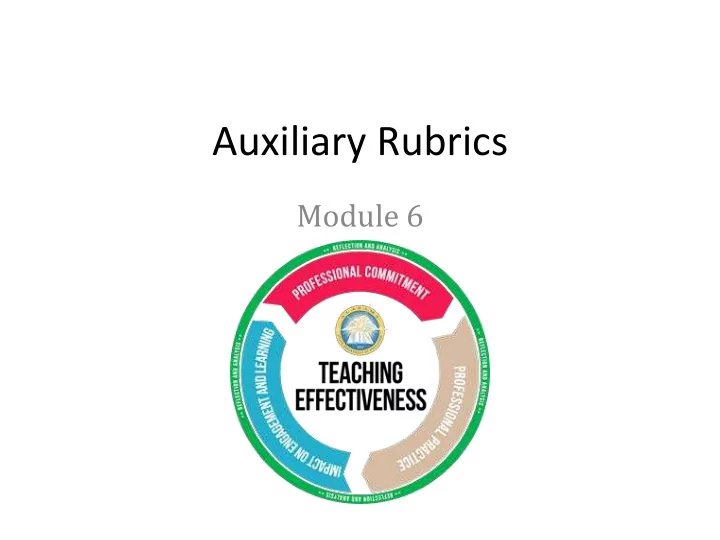

Auxiliary Rubrics Module 6
Module 5 Review At the conclusion of Module 5, the team completed all classroom observation rubrics.
Auxiliary Rubrics Pillar I • Self Assessment, PLP and Evidence Rubric • * Professionalism Rubric Pillar II • Collaboration Rubric • Impact Beyond Classroom Rubric
Pillar 1 Self Assessment, PLP and Evidence • Required Components – Self-Assessment – Professional Learning Plan – Evidence • Platform Options – EDUCATEAlabama – Other Platform
EDUCATEAlabama • Adopted in May 2009 • Aligned to the Alabama Quality Teaching Standards (AQTS) • Formative system designed to provide insight to teachers • Used to set expectations, goals, and a plan of action for professional growth and learning • Self-Assessment, Professional Learning Plan and Evidence
Activity 1 Self-Assessment, PLP and Evidence • How many indicators should be identified as areas of focus? • What is the deadline for submitting the PLP? • Is the PLP purposeful and aligned to AQTS? • Are objectives clear and relevant to student growth? • What is the expectation of the submission of evidence?
Pillar I Professionalism (Optional) To increase the achievement of all students, teachers engage in continuous learning and self-improvement; collaborate with colleagues to create and adopt research-based best practices to achieve ongoing classroom and school improvement; and adhere to the Alabama Educator Code of Ethics and federal, state, and local laws and policies.
Activity 2 Professionalism How does your district currently address the following Alabama Quality Teaching Standards listed below? – Collaborates with stakeholders to facilitate student learning and well being (Indicator 5.1) – Engages in ongoing professional learning to move practice forward (Indicator 5.2) – Participates as a professional learning community member in advancing school improvement initiatives (Indicator 5.3) – Promotes professional ethics and integrity (Indicator 5.4) – Complies with local, state, and federal regulations and policies (Indicator 5.4)
Dennis Sparks “Effective teams strengthen leadership, improve teaching and learning, nurture relationships, increase job satisfaction, and provide a means for mentoring and supporting teachers and administrators.”
Activity 3 Collaborative Planning • “Strong Teams, Strong Schools” by Dennis Sparks – What makes your team strong? – What challenges does your team face? • Read article and complete the key characteristics of effective teams rating • Place a star next to the six characteristics that you feel are most important to collaboration in your district
Activity 4 Impact Beyond the Classroom In what ways do you serve above and beyond your prescribed duties? Think of various communities and extra-curricular activities that do not provide a stipend. Examples include, but are not limited to: – Serve on various committees – Write grants – Club sponsor – Prom sponsor
Design Teams Team 1 – Self Assessment, PLP and Evidence Rubric Team 2 – Professionalism Team 3 – Collaboration Team 4 – Impact Beyond Classroom (Professional Showcase)
Decisions • What platform should be used to facilitate teachers’ self assessment, PLPs, and evidence? • Should we include a Professionalism rubric in our teacher evaluation process? • If we choose to design a Professionalism rubric should we include the expectations for collaboration or create a separate Collaboration rubric? • As we showcase teachers’ impact beyond the classroom, should we rate, rank, or provide a checklist?
Design Teams Work Session • Design teams will begin the creation of an assigned rubric • Example rubrics are provided in the resource folder • Teams should initially create the “effective” column and gather feedback from other team members before finalizing rubric design
Product Review Part A • Review rubrics created by the other teams • Provide feedback Part B • Review comments made by other teams • Edit and revise assigned rubric
Recommend
More recommend